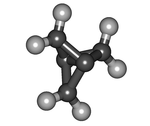In organic chemistry, ring strain is a type of instability that exists when bonds in a molecule form angles that are abnormal. Strain is most commonly discussed for small rings such as cyclopropanes and cyclobutanes, whose internal angles are substantially smaller than the idealized value of approximately 109°. Because of their high strain, the heat of combustion for these small rings is elevated.[1][2]
Ring strain results from a combination of angle strain, conformational strain or Pitzer strain (torsional eclipsing interactions), and transannular strain, also known as van der Waals strain or Prelog strain. The simplest examples of angle strain are small cycloalkanes such as cyclopropane and cyclobutane.
Ring strain energy can be attributed to the energy required for the distortion of bond and bond angles in order to close a ring.[3]
Ring strain energy is believed to be the cause of accelerated rates in altering ring reactions. Its interactions with traditional bond energies change the enthalpies of compounds effecting the kinetics and thermodynamics of ring strain reactions.[4]

- ^ Smith, Michael B.; March, Jerry (2007), Advanced Organic Chemistry: Reactions, Mechanisms, and Structure (6th ed.), New York: Wiley-Interscience, ISBN 978-0-471-72091-1
- ^ Wiberg, K. (1986). "The Concept of Strain in Organic Chemistry". Angew. Chem. Int. Ed. Engl. 25 (4): 312–322. doi:10.1002/anie.198603121.
- ^ Bachrach, Steven M. (1990-11-01). "The Group Equivalent Reaction. An Improved Method for Determining Ring Strain Energy". Journal of Chemical Education. 67 (11): 907. doi:10.1021/ed067p907.
- ^ Dudev, Todor; Lim, Carmay (1998-05-01). "Ring Strain Energies from ab Initio Calculations". Journal of the American Chemical Society. 120 (18): 4450–4458. doi:10.1021/ja973895x. ISSN 0002-7863.